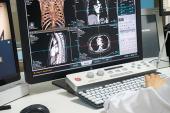Even Less-Severe COVID-19 Can Have Long-term CV Effects
The study showed myriad adverse outcomes through 1 year, and the risk wasn’t restricted to hospitalized patients.

COVID-19 appears to impact the risk of cardiovascular events up to a year later among patients who survive the disease, even those who aren’t hospitalized, according to an analysis of data from the US Department of Veterans Affairs (VA) healthcare system.
The comparison between the COVID-19 survivors and contemporary controls showed that, after an initial 30-day recovery period, there were increases in cerebrovascular disorders, dysrhythmias, inflammation of the heart or pericardium, ischemic heart disease, other cardiovascular disorders, and thromboembolic disorders.
Altogether these contributed 45.29 extra cardiovascular outcomes per 1,000 people between 30 days and 12 months. For MACE alone—the composite of MI, stroke, and all-cause death—the added burden was 23.48 events (HR 1.55; 95% CI 1.50-1.60), Yan Xie, PhD (VA St. Louis Health Care System and Saint Louis University School of Medicine, MO), and colleagues report in Nature Medicine.
“The risks were evident regardless of age, race, sex, and other cardiovascular risk factors, including obesity, hypertension, diabetes, chronic kidney disease, and hyperlipidemia; they were also evident in people without any cardiovascular disease before exposure to COVID-19, providing evidence that these risks might manifest even in people at low risk of cardiovascular disease,” they note.
Senior author Ziyad Al-Aly, MD (VA St. Louis Health Care System and Saint Louis University School of Medicine), told TCTMD that, going into the project, he’d expected to see the long-term sequelae concentrated “in people who are, to start with, very sick or have high cardiovascular risk—maybe people who are obese, smokers, and people who have kidney disease or diabetes.”
Yet this wasn’t the case, he said. “What’s surprising is really the observation that it really spared almost nobody. . . . It really was across the board.”
COVID-19 is a cardiovascular risk factor. . . . It’s very important that people think of it like that. Ziyad Al-Aly
Khurram Nasir, MD, MPH (Houston Methodist, TX), commenting on the new findings, said suspicions that COVID-19 would have lasting CV effects arose early in the pandemic. “Almost 2 years back, at least after the first few months, we were all realizing there’s a clear sign that some of these patients were having an increased risk of cardiovascular complications,” such as thrombotic events, he noted to TCTMD. Also, “there were some studies that postulated there may be long-term myocardial and vascular damage.”
Recent research has unearthed signs of subclinical impact across organ systems. With these latest results, there’s now evidence of an actual increase in CV events among patients who’ve recovered from COVID-19, where the risk goes beyond what was seen in the general population during the pandemic. “In this regard, this study is critically important,” said Nasir. Though questions remain, “I think it’s safe to say now that, clearly—at least based on this very robust, very well-done, large-scale study—individuals with COVID are also going to have a higher risk of cardiovascular disease up to 1 year.”
Going forward, it will be important to see if these findings can be replicated, but already this paper is “an eye-opener,” he commented. “It is definitely something that compels us in cardiology to think more, and be more [of an] advocate, joining hands with our colleagues in medicine, infectious disease, and [other specialties].”
Al-Aly was equally emphatic that it’s time to apply this knowledge: “COVID-19 is a cardiovascular risk factor. . . . It’s very important that people think of it like that.”
Data on Millions of US Veterans
Using the VA national healthcare databases, the researchers identified 153,760 veterans who survived the first 30 days after receiving a COVID-19 diagnosis between March 1, 2020, and January 15, 2021. Patients had a mean age of 61 years, 71% were white, and 89% were male. These individuals were compared against a contemporary cohort of 5,637,647 veterans who had no evidence of SARS-CoV-2 infection. Median follow-up times were 347 and 348 days, respectively.
Among COVID-19 survivors, the sharpest increases in risk during the period between 1 and 12 months were seen for myocarditis (HR 5.38; 95% CI 3.80-7.59), pulmonary embolism (HR 2.93; 95% CI 2.73-3.15), cardiac arrest (HR 2.45; 95% CI 2.08-2.89), cardiogenic shock (HR 2.43; 95% CI 1.86-3.16), and deep vein thrombosis (HR 2.09; 95% CI 1.94-2.24). The rarity of myocarditis, cardiac arrest, and cardiogenic shock meant that their estimated burdens per 1,000 people at 12 months were just 0.31, 0.71, and 0.51, respectively, compared with contemporary controls. However, the burdens posed by pulmonary embolism and deep vein thrombosis were greater, at 5.47 and 4.18 added cases.
Some conditions had a lower hazard ratio, yet due to their frequency affected a larger number of individuals. Others included heart failure (burden 11.61 per 1,000 people at 12 months; HR 1.72; 95% CI 1.65-1.80), atrial fibrillation (burden 10.74; HR 1.71; 95% CI 1.64-1.79), sinus tachycardia (burden 5.78; HR 1.84; 95% CI 1.74-1.95), acute coronary disease (burden 5.35; HR 1.72; 95% CI 1.56-1.90), sinus bradycardia (burden 4.62; HR 1.53; 95% CI 1.45-1.62), ventricular arrythmias (burden 4.18; HR 1.84; 95% CI 1.72-1.98), and stroke (burden 4.03; HR 1.52; 95% CI 1.43-1.62). Smaller but still significantly increased risks and burdens also were seen for nonischemic cardiomyopathy, atrial flutter, MI, superficial vein thrombosis, angina, transient ischemic attack, and pericarditis.
Xie and colleagues also analyzed the data based on whether people weren’t hospitalized (n = 131,612), were admitted to the hospital (n = 16,760), or required intensive care (n = 5,388) while sick with COVID-19. “These risks and burdens were evident even among individuals who were not hospitalized during the acute phase of the infection and increased in a graded fashion according to the care setting,” they write.
Their results were consistent when compared with a cohort of 5,859,411 historical control patients who received care within the VA healthcare system in 2017. Additionally, CV risks were higher after exposure to COVID-19 compared with before exposure, the researchers report, and further analyses showed COVID-19 vaccination didn’t explain any of the added myocarditis and pericarditis risks.
‘Urgent, Coordinated Care’ Required
As for likely mechanisms, Al-Aly cited several possibilities. It may be that “the body’s immune reaction to the virus and the intensity of it may cascade down to become autoimmune,” he said. Another is that the spike protein’s engagement with the ACE2 receptors, “nearly ubiquitously present on almost every human cell,” could be provoking adverse outcomes. For now, these are just hypotheses, and there’s no reason to think they’re mutually exclusive, Al-Aly added. “Biology does not work like that, and life does not work like that. A lot of times it could be two or three mechanisms at play at any point in time.”
Al-Aly said that, to him, all of these aftereffects “that wouldn’t have happened otherwise” fall under the umbrella of “long COVID,” irrespective of whether patients were having noticeable, lingering symptoms. The CV events, in and of themselves, are “one facet of the multifaceted ‘long COVID,’” he explained.
Time-wise, events were “a little bit front-loaded,” occurring at a higher frequency in the first 6 months of follow-up, though not exclusively in that earlier window, said Al-Aly. Their study doesn’t reveal what happens beyond 1 year, he pointed out. “Arguably, there could be actually [higher risk] up to a year-and-a-half or 2 years. We don’t really know yet.”
Nasir agreed that for COVID-19 survivors, it’s too early to truly know the long-term ramifications. “There is a possibility that the risk may even continue to remain the same or grow [for them] in the ensuing years,” he said, which reiterates the key message: “Prevent COVID. . . . Vaccination is the answer.”
The study also emphasizes the need for preventive cardiology, he added. “Especially [for patients who’ve] had prior COVID, I would be paying more attention to them and having a greater due diligence” when it comes to risk assessment and management. COVID-19 should be considered a “risk-enhancing factor,” Nasir said, specifying that extra attention should be paid to vulnerable populations, such as racial/ethnic minorities and people who face difficulties like access to transportation.
Overall, this situation calls for “urgent, coordinated care,” not just in the US but in low- and middle-income countries, where the burden might even be higher, he stressed.
Both Nasir and the study authors observed that it’s hard to predict the future. “As the pandemic, with all its dynamic features, continues to progress, as the virus continues to mutate and as new variants evolve and as vaccine uptake improves, it is possible that the epidemiology of cardiovascular manifestations in COVID-19 might also change over time,” Xie et al write.
Caitlin E. Cox is News Editor of TCTMD and Associate Director, Editorial Content at the Cardiovascular Research Foundation. She produces the…
Read Full BioSources
Xie Y, Xu E, Bowe B, Al-Aly Z. Long-term cardiovascular outcomes of COVID-19. Nat Med. 2022;Epub ahead of print.
Disclosures
- Xie, Al-Aly, and Nasir report no relevant conflicts of interest.





Comments